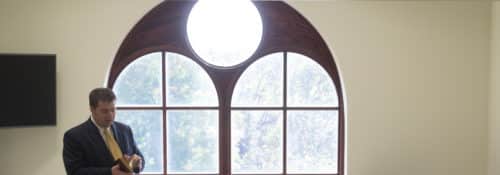
Cool Class: History of the Book
Written by Monica Vanderweide
What goes into making a book? How have books evolved from Gutenberg’s day to the present? Is a bookless future a real possibility? Hillsdale bibliophiles examine these questions—as well as items from the College’s rare book collections—in “History of the Book,” a class taught by Assistant to the Provost and Lecturer in English Mark Maier.
Maier, who holds a master’s degree in library science and previously worked in Mossey Library, modeled the course after one he took in graduate school at the University of South Carolina. “Books have a complicated history,” he says. “So many people play a role in bringing a book to life—editors, designers, and publishers, to name a few. Furthermore, the physical nature of the book—the typography, binding, dust jacket—impacts the reader’s experience.” Maier got the “rare book bug” after reading a book that Professor of English John Somerville recommended: Double Fold: Libraries and the Assault on Paper by Nicholson Baker. The book criticizes the practice of libraries microfilming old newspapers and books and then discarding the originals. “Reading that book led me to interview the author for a class project in graduate school, and then I got an assistantship in the university’s rare books library,” Maier recalls. “I love rare books, and this class gives me an opportunity to showcase some of the College’s collections.”
To reinforce history lessons within the course readings, Maier brings artifacts from the Mossey Library’s Heritage Room to class so that students can physically experience these rare and, in some cases, original editions, including a collection of Old English Bibles, an autographed copy of James Joyce’s Ulysses, a 1698 collection of John Milton’s works, and an original first edition of Walt Whitman’s Leaves of Grass.
Junior English major Katarzyna Ignatik says that the class has opened her eyes to a different way of looking at books. “It’s refreshing to explore literature from a different perspective; it’s more of a historical perspective than a critical analysis,” she says.
That is exactly what Maier hopes his students will get out of the class—books are more than just containers of information, and each book has a story behind its genesis. And with digital storage still too new to have its long-term viability tested, Maier hopes students will grasp the importance of preservation. “Books endure,” he says with a smile.
This article was originally published in the Winter 2019 edition of Hillsdale: The Official Magazine of the Hillsdale College Alumni Association.